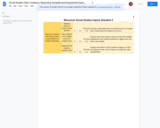
Assessment template to guide students in a standards-based grading classroom on Social Studies Standard 3: CER.
- Subject:
- Civics and Government
- Social Studies
- Material Type:
- Assessment
- Rubric/Scoring Guide
- Author:
- Jake Boll
- Date Added:
- 09/27/2022

Assessment template to guide students in a standards-based grading classroom on Social Studies Standard 3: CER.

This text set includes a variety of multimodal resources designed to help learners understand treaty rights as they apply to the state of Wisconsin, giving special emphasis to the court cases of LCO v. Voight and State v. Gurnoe. Indian tribes were independent, sovereign nations, before the arrival of Europeans in North America. Despite ceding their lands in the northern part of Wisconsin to the U.S. government, Chippewa tribes reserved the right to hunt, fish, and gather within the Ceded Territory. In the 1980’s, these court cases affirmed those rights. The year 2024 celebrates 50 years of the court decision.
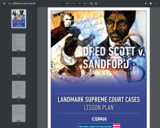
Using C-SPAN’s Landmark Cases website and programs, students will simulate the Supreme Court hearing of Dred
Scott v. Sandford (1857), otherwise known as the Dred Scott Case. Students will read the case scenario and take
on roles of either an attorney or Supreme Court Justice as if they lived in the 19th century. After studying the case,
both teams of attorneys will present their cases in written and oral form and receive questions from the justices.
Afterwards, the justices will facilitate oral argument and offer written opinions. Finally, the class will debrief the
experience and read and discuss the actual decision.
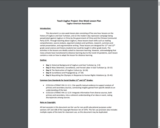
"This document is a one-week lesson plan consisting of five one-hour lessons on the
history of Uyghurs and East Turkistan, and on the modern-day repression campaign being
perpetrated against Uyghurs in China by the government of China and the Chinese Communist
Party (CCP). Through teaching about Uyghurs, these lessons teach skills such as reading
comprehension, source analysis, argument analysis and synthesis, research, summary and
verbal presentation, and argumentative writing. These lessons are designed for 11th and 12th
grade social science and history students but could be taught in other grade levels. The
activities in the lessons are ideally suited to classroom learning. However, acknowledging that
many schools have transitioned to distance learning due to the Covid-19 pandemic, each lesson
contains a note on how to adapt the lesson for distance learning. "
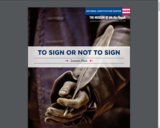
On Constitution Day, students will examine the role of the people in shaping the United States Constitution. First, students will respond to a provocative statement posted in the room. They will then watch a video that gives a brief explanation of the Constitutional Convention of 1787, or listen as the video transcript is read aloud. A Constitution poster is provided so students can examine Article VII and discuss it as a class.
The elementary and middle school educator will then
guide students through a read-aloud play depicting two Constitutional Convention delegates who disagreed about ratifying the Constitution.
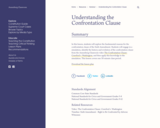
In this lesson, students will explore the fundamental reasons for the confrontation clause of the Sixth Amendment. Students will engage in a simulation, identify the history and evolution of the confrontation clause from the Annenberg Classroom video The Confrontation Clause: Crawford v. Washington, and then apply this knowledge to the simulation.
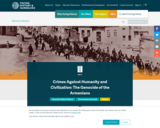
This series of eight lessons is organized as a mini-unit for teaching the Armenian Genocide. They were designed to complement Facing History and Ourselves' resource books, Holocaust and Human Behavior and Crimes Against Humanity and Civilization: The Genocide of the Armenians. Most of these lessons are designed to be used with the film The Armenian Genocide (Two Cats Productions), which aired on PBS on April 17, 2006 and is available to borrow from our library or stream if you are in our educator network. These texts depict, in words or images, evidence of horrible atrocities such as murder and starvation. We recommend previewing materials in order to gauge if they are appropriate given the maturity level of your students.
While we estimate that teaching all eight lessons would require approximately 10 hours of class time, we know that the actual pacing of these lessons depends on your students and your context. These lessons can also by used individually with the understanding that the later lessons rely on students' previous knowledge of the Armenian Genocide. It is our hope that you use these lessons as a jumping off point in creating learning experiences that will engage students in the history of the Armenian Genocide and the important questions this history raises about human behavior.
Language note: While this unit is titled "The Genocide of the Armenians," the word genocide did not exist in 1915 when the Armenians were being massacred and forced on death marches. To avoid historical anachronism, the first seven lessons of this unit circumvent the use of the word "genocide" with students. The final lesson introduces students to the modern term "genocide," and to the different ways people claim or deny this term. You might choose to introduce students to the term "genocide" earlier in the unit, while informing them that the events they are learning about inspired the genesis of this term.
Something to think about: The purpose of these lessons is to help students understand a particular moment in history, the Armenian Genocide, as a way to explore core questions about human behavior. While students are asked to travel across time and space in order to connect this history to their own ideas and experiences, it would be irresponsible for students to make generalizations about a particular religious or national group that cuts across time and place. In other words, students should be strongly discouraged from seeing this history as a lesson about all Turks, all Muslims, all Armenians, or all Americans, in the same way that scholars who teach about the Holocaust are careful not to condemn all Germans or all Christians for acts committed by the Nazis and their followers.
Background
In our increasingly interconnected world it has become clear that what happens in one country affects all of us in many ways, some more visible than others. Responding to genocide, ethnic violence, and abuses of human rights stand as the primary challenges of our day. There was great hope that the end of the Cold War would usher in a new era with a blossoming of democracy and human rights; instead violence around the world makes it clear that finding the tools to prevent genocide is as urgent as ever. Historians note that in the last hundred years more human beings died through genocidal violence and state-sanctioned murder than on that era's countless battlefields.
It was no accident that the failure to prevent escalating abuses of the human rights of Ottoman minorities climaxed with the systematic deportation and mass murder of the Armenian population of the empire in World War I. While other minority groups had broken free from the Ottoman Empire, the Armenians hoped that reforms--supported by the Western powers-would bring change. Instead a new nationalism spread through the Ottoman leadership that left no place for the Christian minorities within the empire. Under the cover of World War I the genocide of the Armenians began.
In 1915 journalists, politicians, and ordinary people considered how best to respond to the accounts of "horrors" and "outrages" in Turkey's Anatolian desert. Unable to remain silent, local and national leaders challenged tradition by boldly proclaiming that responsibility for human life does not stop at national borders. Their solutions set important precedents for international law. In fact, the phrase "crimes against humanity," made famous as one of the counts at the post-Holocaust Nuremberg Trials, was first used to describe the massacres of Armenian civilians in the spring of 1915.
As the pillaging of Armenian villages continued, diplomats debated questions of national sovereignty. In the absence of military intervention, coalitions of individuals, religious groups, and voluntary associations were able to raise millions of dollars to house and feed refugees from the slaughter. While those efforts saved many, humanitarian relief alone could not stop the mass murder of women, children, and men. In the wake of the genocide, official promises to hold the perpetrators accountable faded, as did support for the new Armenian state.
To many who had followed the bloody history of Turkey's campaign against its own people, the impunity enjoyed by those who had ordered and carried out the killings was unbearable. One of them was Raphael Lemkin, a Polish Jew and a law student. Lemkin confronted one of his law school professors. He asked, "Why is the killing of a million people a lesser crime than the killing of a single individual?" His professor used a metaphor to explain that courts did not have any jurisdiction: "Consider the case of a farmer who owns a flock of chickens. He kills them and this is his business. If you interfere, you are trespassing." But, replied an incensed Lemkin, "the Armenians are not chickens." Lemkin dedicated the rest of his life to finding a way to make sure that the law would recognize the difference. In 1944 Lemkin coined the word "genocide" and later he drafted the United Nations Convention on Genocide. The convention was ratified on December 9, 1948, one day before the adoption of the Universal Declaration of Human Rights.
Although this convention requires that its signatories take whatever steps are necessary to prevent genocide, too often the international community does little but stand by while mass killings continue in places like Sudan and the Democratic Republic of the Congo. In his role as a columnist for the New York Times, Nicholas Kristoff warns readers about the consequences of silence. "There is something special about genocide," he writes, "When human beings deliberately wipe out others because of their tribe or skin color, when babies succumb not to diarrhea but to bayonets and bonfires, that is not just one more tragedy. It is a monstrosity that demands a response from other humans. We demean our own humanity, and that of the victims, when we avert our eyes."
We hope that this series of lessons will help a new generation to understand that genocide is a threat to all of us: it is indeed a "crime against humanity."

This assessment gauges students’ ability to reason about how evidence supports a historical argument. Students must explain how a floor plan of the building that acted as the United Farm Workers Headquarters and a poster made by the Young Americans for Freedom both support the conclusion that the UFW was influential.
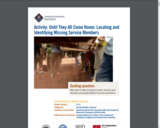
Using resources from the Defense POW/MIA Accounting Agency and the American Battle Monuments Commission, students will learn about the recovery and identification pro- cess of missing service members’ remains. The students will demonstrate their understanding of the recovery process by researching the location of a missing service member and developing a pre-mission report for that area.
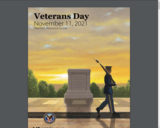
Important information about how to honor Veterans in school and classroom settings. The activities in this 2021 guide can be applied to any year. The VA publishes a new guide every year.
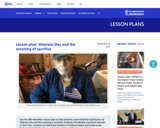
Use this PBS NewsHour lesson plan to help students understand the significance of Veterans Day and the meaning of sacrifice. Students will identify important veterans in their lives, examine an interactive timeline of military history and study issues facing veterans today
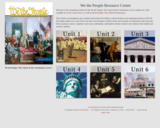
This website was designed to give students and teachers the ability to electronically access important portions of the We the People student text, such as the Unit and Lesson Purposes and the Terms and Concepts to Understand, and to provide links to primary sources, Supreme Court cases, multimedia, and helpful websites related to the content of the student and teacher's editions.
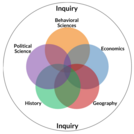
The Wisconsin DPI started rolling out the new Wisconsin Social Studies Standards (WISSS) during the 2018-19 school year. Districts are interested in learning about high-quality instructional resources for the social studies classroom; however, neither IMET nor EdReports has undertaken a resource review for social studies. In an effort to provide some direction for districts seeking to adopt aligned high-quality resources for social studies, CESA 8 led a collaborative team of Grades 6-12 social studies teachers from 6 of our 27 districts in creating a repository of social studies resource reviews which assess alignment to the new Wisconsin Social Studies standards, as well as focus on the shifts in pedagogy contained within the new standards.

Who comes to mind when considering the Modern Civil Rights Movement (MCRM) during 1954 - 1965? Is it one of the big three personalities: Martin Luther King Jr., Malcolm X, or Rosa Parks? Or perhaps it is John Lewis, Stokely Carmichael, James Baldwin, Thurgood Marshall, Ralph Abernathy, or Medgar Evers. What about the names of Septima Poinsette Clark, Ella Baker, Diane Nash, Daisy Bates, Fannie Lou Hamer, Ruby Bridges, or Claudette Colvin? What makes the two groups different? Why might the first group be more familiar than the latter? A brief look at one of the most visible events during the MCRM, the March on Washington, can help shed light on this question.Students will be able to conduct an inquiry into the following research questions through this source:Who were some of the women leaders of the Modern Civil Rights Movement in your local town, city, or state? What were the expected gender roles in 1950s - 1960s America?Did these roles vary in different racial and ethnic communities?How would these gender roles affect the MCRM?Who were the "Big Six" of the MCRM?What were their individual views toward women in the movement?How were the ideas of gender similar or different from the MCRM and the later Black Power Movement?How did African American women in the MCRM relate to women in other women movements of the era (ex. Chicano, LGBT, or American Indian Movement)?

The goal of this module is to provide resources and information about the history of women’s vote in the U.S. Looking at the women’s suffrage movement provides a framework for exploring the changing role of women in politics and society in the 19th and 20th centuries. The history of suffrage offers an opportunity to examine women’s roles at critical points in the nation’s history, and to think about the impact of women’s voting behavior on politics in our time.
Activities and discussion questions are designed to explore the changing role of women in society and in politics. The module includes ideas for developing lessons on women’s suffrage and integrating the issue of suffrage into lessons on US history and politics, and to consider the impact of full suffrage on politics and society today.
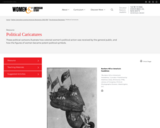
The events of the American Revolution took place just when political cartoons became very popular in England. People gathered every day at print shops all over London to learn the news and see the latest cartoons mocking the events of the day. Politicians quickly learned the power of a good cartoon. There is even evidence that some English politicians hired artists to mock their enemies and improve their own standing.
Students will be able to examine and analyze various political cartoons on the empowerment of colonial women and how through political cartoons, their actions were displayed and perceived by individuals of the period. Students will be able to use historical thinking skills to understand how images play a vital role in spreading information and sentiments.

Plastic bottles are everywhere! About 70% of the plastic water bottles bought in the U.S. are not recycled, and end up in the oceans. It seems obvious that using fewer plastic water bottles would be a good thing for our environment, but sometimes the alternatives can have negative consequences. Do the costs of banning plastic bottles outweigh the benefits?